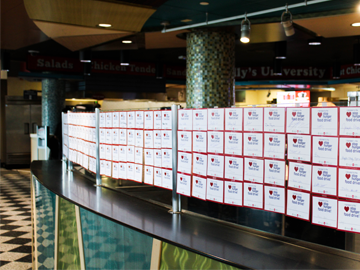It’s no secret: the holidays can be lonely on campus.
More than half (53%) of current college students admit to feeling lonely.1 For some, it’s their first time away from home. For others, they’re trailblazing as the first member of their family to pursue higher education. For all students, complex factors like food insecurity can disrupt even the most vibrant social groups.
Growing a supportive campus community is a major factor in banishing loneliness and building student resilience. And since sharing meals with friends is the go-to social outlet for 87% of Gen Z students, it’s clear the foundation of a strong campus community begins in the dining hall.1
To learn what students need today from their campus dining experience, we launched The Quad Squad earlier this semester. This 300-strong student community is expanding our robust set of listening tools to help us understand what students really think, from everyday thoughts on hanging out at dinner to big-picture opinions on issues like food insecurity.
Listen to how The Quad Squad is helping us use live data to build stronger on-campus communities.
How food insecurity impacts student communities
This semester, The Quad Squad is investigating issues that hit home around the holidays, like food insecurity. Here’s why: 32% of students are unable to afford or access adequate nutrition. They skip meals to save money. They avoid going out with friends.1 This issue affects the entire student body, not just those who are food insecure. Maybe it looks like a few empty chairs (and fewer voices) around the table. Maybe a holiday tradition just isn’t shared this year.
To find out more, we turned to The Quad Squad.
What students are saying about food insecurity on campus
From dining halls operated by Sodexo, to partner universities and competitor colleges, we asked students what they thought about how their campus dining service is tackling this hot-button topic. Here’s what they told us:
Campuses offer first-step solutions
“At my school, we have a campus food bank where any student can come once a week to get food and basic necessities,” a third-year student shared. “This is a good start to addressing food insecurity, but it’s based on donations and there isn’t enough available for it to fully address the problem.”
Free meal programs and grocery banks were other on-campus solutions The Quad Squad mentioned. However, some students admitted they either didn’t know how to access them, or they couldn’t effectively use the resources.2

Students face common barriers to food security
“We have a food pantry,” shared a sophomore commuter with a meal plan, “but many groceries have to be cooked and some students don’t have a kitchen.” Commuters without meal plans told us the financial impact of dining on campus affected their food security. One student even revealed she spends most of her income on campus dining.2
According to The Quad Squad, common challenges students face include the cost of meal plans and dining hall restrictions regarding taking food home. Limited dining hall hours were another barrier students encountered.2 One sophomore shared that he regularly had to skip meals due to dining hall hours. “If you play a sport or prefer to go to the gym at night,” he shared, “then you either have to eat before practice or skip dinner on the weekdays.”
How campuses are responding to food insecurity

Campuses around the country are working on tackling food insecurity, but the issue is complex. One student worker told us, “We have a program where students can apply for free ‘meal swipes’ to get into our main dining hall. However, enrollment is rising, so the number of swipes per student has had to go down. We’re considering allowing students to donate some of their swipes to those in need. We hope this will raise awareness and build a sense of togetherness.”
Across the board, students were passionate about uplifting their peers facing food insecurity. And many believed their campus communities could be doing more.2
How Sodexo is helping campuses take action
Sodexo proudly helps colleges and universities across the U.S. establish or expand food pantry programs. This offers students ready access to toiletries, dry goods, fresh fruit, sandwiches, and snacks, with some variation depending on the campus community the pantry serves. This is a vitally important effort, as food pantries see an increase in need every year.
The Sodexo Stop Hunger Foundation also works with campuses to smash food insecurity. This effort gives students the chance to support food-insecure peers with donations from their meal plans. “When a student gives a donation,” one university shared with us, “they receive a Stop Hunger voucher. The donation is used to purchase food for the on-campus food pantry.” Students on participating campuses can also build the food security of their local community through Stop Hunger’s collaboration with regional nonprofits. This holiday season, one campus was able to donate 16,209 meals to community members in need.3
Building a resilient campus community starts with real-time data
Like our partners, we’re passionate about building a student-first community. And The Quad Squad is helping us understand what students need today. Our goal? To use what we learn to build a curated dining environment...one that’s a foundation for a strong community...one that fosters student resilience...and one that’s the perfect place to hang out over a holiday meal.


[1] 2022-2023 Sodexo Student Lifestyle Survey.
[2] Quad Squad data collected November 2023.
[3] Sodexo client data, collected November 2023.
